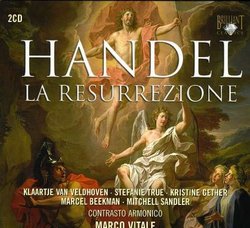| All Artists: Handel, Marco Vitale, Contrasto Armonico Baroque Title: George Frideric Handel: La Resurrezione Members Wishing: 1 Total Copies: 0 Label: Brilliant Classics Original Release Date: 1/1/2009 Re-Release Date: 6/2/2009 Genre: Classical Styles: Opera & Classical Vocal, Symphonies Number of Discs: 2 SwapaCD Credits: 2 UPCs: 842977038057, 5028421938059 |
Search - Handel, Marco Vitale, Contrasto Armonico Baroque :: George Frideric Handel: La Resurrezione
 | Handel, Marco Vitale, Contrasto Armonico Baroque George Frideric Handel: La Resurrezione Genre: Classical
|
Larger Image |
CD Details |
CD ReviewsThe Real Resurrection ... Giordano Bruno | Wherever I am, I am. | 11/25/2009 (5 out of 5 stars) "... is of George Frideric Handel's magnificent Italian cantatas and oratories, composed during the decade he spent in Rome, living on the patronage of the cardinals and princes of the Arcadian establishment. It wouldn't take much to persuade me that he did his best work there and then, and his "Oratorio per la Risurretione di Nostro Signor Giesu Cristo" is prime evidence. First performed on Easter Sunday of 1708, under the patronage of the Marchese Francesco Maria Ruspoli, The Resurrection fulfills all the Counterreformation ideals of a "opera at the altar", a work of artistic splendor based on sound theological pedagogy. More than two hours long, and demanding a full orchestra of strings and winds - on this recording there are 26 instrumentalists - the work abounds with scenic and dramatic qualities, though inevitably the music is so richly inventive that any staging would be gilding the lily. The Marchese, by the way, got himself a reprimand from the Pope directly for allowing a woman to sing the role of Mary Magdalene in the premiere. That woman was soprano Magherita Durastanti, who made most of her career singing for Handel in Italy and England. Her place was taken in the second performance by a castrato, with the Pope's blessing.
There are only five characters in the cast: Maddalena and Cleofe, the women who discover the empty tomb; an Angelo who tells them that the Lord has risen; San Giovanni, to whom the two women deliver the news; and Lucifer. The five soloists sing briefly as a chorus at the end of each act of the drama. The actual resurrection takes place offstage and is reported by witnesses, as in a Greek tragedy. And this resurrection is, in a sense, a dramatic tragedy, depicting the hubris and anguish of Lucifer, who dominates the libretto as vividly as does Satan in John Milton's 'Paradise Lost'. Giesu Cristo makes no personal or vocal appearance in his own resurrection. Lucifer's music is composed to be dramatic rather than ingratiating; it's jagged and boisterous, with lots of large vocal leaps of fourths and fifths. Bass Mitchell Sandler delivers exactly the snarly arrogance the role demands, with the appropriate bluster and yet with superb vocal technique. His exchanges in recitativo with the Angel, sung with angelic clarity by soprano Klaartje van Veldhoven, strike just the right contrast of false bravura versus revelation. Their duet in act two - 'Impedirlo sapro' - is a highlight of the oratorio. Even more lovely, however, is the act 1 duet between Maddalena and Cleofe - 'Dolce chiodi' - sung by soprano Stephanie True and alto Kristine Gether. Their duet would get itself included on my CD of Handel's greatest hits. So would the aria 'Per me gia di morire', sung in deepest sorrow by Maddalena just before the Tomb is discovered to be empty. Tenor Marcel Beckman completes the cast in the role of Saint John; though none of his arias are show-stoppers like those of Maddalena, Beckman sings beautifully, with a pure youthful voice of the sort 'invented' by Monteverdi and beloved of Italian composers ever since. Conductor Marco Vitale selected his soloists well, not only for their technical skills but also for the match of their voices with their dramatic personae. Most of the recitativos are accompanied only by harpsichord and cello, but the arias are resplendent with instrumental colors - paired violins, trumpets, flutes, reeds, gambas - complementing the voices with the sort of athletic obbligatos that Handel could compose better than anyone. Marco Vitale is a scholar as well as a musician, and his notes are worth reading, particularly when he justifies some of his more unusual choices of instrumentation, for example his use of a trombone as a continuo bass for arias featuring the trumpets as obbligato. This is a meticulously "authentic" historically informed performance, even using the low pitch -- A 392 -- in fashion in early baroque Rome. If you are interested in questions of historic pitch, you'll find Vitale's arguments persuasive. The only flaw in this two-CD performance package is a minor annoyance with the libretto. It's all there, in Italian, English and German, but the pages are assembled out of order (at least in my copy), so that you'll need to check the page numbers to follow the text. In every other way, this is a magnificent addition to the growing revived repertoire of Handel's brilliant youthful masterworks." |

 Track Listings (25) - Disc #1
Track Listings (25) - Disc #1